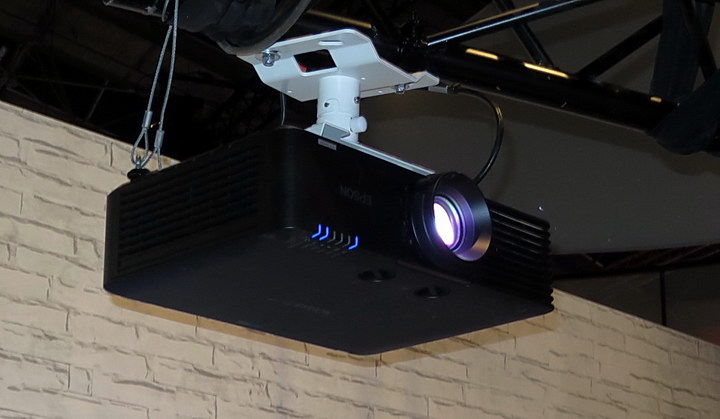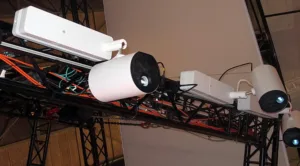Epson Europe must have been busy in the time leading up to ISE, where they showed multiple new projectors. This included the 2,000 lumen LightScene EV-100, the 12,000 lumen EB-L12000Q (shown with a new lens), the 20,000 lumen EB-L20000U and the EB-L610U, one of five similar laser/phosphor 3LCD boardroom projectors that range from 4,500 to 6,000 lumens. Epson also announced a new software tool for setting up its new and existing range of installation projectors.
Three Epson EV-100 projectors at ISE. (Credit: M. Brennesholtz)
Normally a new 2,000 lumen projector doesn’t make much of a stir. The LightScene EV-100 is different, however, both in design and target market. The projector comes in two separate but attached pieces, the projector head and the projector electronics. When hung overhead in a store or other venue, the system looks more like track lighting than a conventional projector. A track, in fact, is an available option for the projector. Once the electronics are mounted, the projector head can be aimed without moving the electronics. Epson says the
“EV-100’s unobtrusive design is ideal for curated visual environments such as retail showrooms, shop window displays, museum exhibits and art installations, where minimal visual clutter is key. It can be used to provide information, show video or moving patterns, and even projection map imagery onto small objects.”
To match the design of the application, the EV-100 comes in either a white (EV-100) or a black (EV-105) case.
The laser illumination system not only allows very long life (20,000 hours) but allows the projector head to be mounted at any angle. The projector has 2000 lumens from its 3LCD WXGA (1280 x 800) light engine. The EV-100 can play content from a SD card or, using iProjection, over the Ethernet connection, which also controls the projector. Full specifications on the projector are not yet available and, curiously, while the press release announcing it gives some details, there is no mention of the projection lens used by the EV-100. Given its target application, I would assume it is a powered zoom and focus lens, but Epson hasn’t said.
The LightScene EV-100 will be available from June 2018.
 The Epson EB-L12000Q projector with the new ELPX02 short throw zoom lens. A portion of the image produced is visible in the upper left hand corner of the photo. The appearance of the EB-L20000U is virtually identical. (Credit: M. Brennesholtz)
The Epson EB-L12000Q projector with the new ELPX02 short throw zoom lens. A portion of the image produced is visible in the upper left hand corner of the photo. The appearance of the EB-L20000U is virtually identical. (Credit: M. Brennesholtz)
Epson says the 12,000 lumen EB-L12000Q is the the industry’s first 12,000-lumen native 4K 3LCD projector. It is similar to the 20,000 lumen WUXGA (1920 x 1200) EB-L20000U, launched at the same time, and the two projectors share a compact case design. Epson has not announced the pixel count or aspect ratio of the EB-L12000Q so it is not known if the projector is true 4K or UHD. Native contrast for the EB-L12000Q is 2500:1 and for the EB-L20000U is 1200:1.
 Control and input panel for the EB-L20000U. (Credit: M. Brennesholtz)
Control and input panel for the EB-L20000U. (Credit: M. Brennesholtz)
Of course, both projectors have a laser-phosphor light source and they each have a 20,000 hour warranty. They also have a sealed optical unit to protect against dust and smoke, although they are not filter-free. Another feature the two projectors share is a built-in high-resolution camera to simplify installation, geometry correction and edge blending. Both models are also compatible with the same 4K-compatible lenses used by Epson’s EB-L1000-Series projectors and both support HDR. In addition, the ELPX02 short throw zoom lens (0.67 – 0.77:1) was also introduced at ISE and will fit either projector. Both have a variety of interfaces and interchangeable interface boards but the EB-L12000Q supports 12G SDI while the EB-L20000U does not.
The EB-L20000U and the EB-L12000Q will be available next winter.
 Epson showed the new EB-L615U at ISE. (Credit: M. Brennesholtz)
Epson showed the new EB-L615U at ISE. (Credit: M. Brennesholtz)
The newly introduced, entry-level EB-L615U, EB-L610U, EB-L610W, EB-L510U and EB-L400U projectors are designed to replace existing lamp-based projectors in scenarios requiring 4,500-6,000-lumen solutions. Leon Mclean, product manager, Epson Europe, said,
“There’s currently a substantial and growing movement within corporate and educational establishments to change from lamp-based projectors to laser models. We regularly get asked by major customers for entry-level laser models in the 5,000-6,000-lumen range, so we decided to fill this need. The advantages are clear – greater reliability, far less maintenance and a lot more versatility.”
The EB-L615U, EB-L610U, EB-L610W, EB-L510U and EB-L400U will be available from June 2018. Properties of the projectors are shown in the table.
|
Key features |
EB-L615U |
EB-L610U |
EB-L610W |
EB-L510U |
EB-L400U |
|
Brightness |
6,000lm |
6,000lm |
6,000lm |
5,000lm |
4,500lm |
|
Housing colour |
Black |
White |
White |
White |
White |
|
Native resolution |
WUXGA |
WUXGA |
WXGA |
WUXGA |
WUXGA |
|
HDBaseT connection option |
● |
● |
● |
– |
– |
|
Up to 20,000 hours maintenance-free use |
● |
● |
● |
● |
● |
|
Flexible connection options including HDMI and HDBaseT |
● |
● |
● |
● |
● |
|
Simple 360º installation and projection at any angle |
● |
● |
● |
● |
● |
|
Screen mirroring |
● |
● |
– |
– |
– |
|
Rear cable cover to conceal leads and connectors |
● |
● |
● |
● |
– |
|
Lens shift |
● |
● |
● |
● |
– |
|
Credit: Epson |
|||||
Epson also announced its Professional Projector Tool, a new free software utility for its 3LCD laser installation projectors. The tool is intended to make multiple-projector implementations quicker and easier to set up, and will give users access to more advanced techniques such as edge blending and projection mapping.
The software is compatible with existing installation projectors including the EB-L25000U, EB-L1500U and EB-L1700U, and will be compatible with the forthcoming EB-L20000U and EB-L12000Q models on launch.
The Epson Professional Projector Tool is designed to be used in conjunction with Epson installation projectors, mainly in installation of rental applications, though it can also be used for fixed installations as well. It allows the user to adjust lens focus or position remotely, and control basic projector functions such as turning power on and off or displaying a test image. – Matthew Brennesholtz

